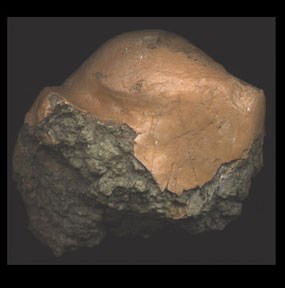
The Fossil Record 5/16/96 - by Ted Fremd, John Day Fossil Beds National Monument Paleontologist Could the largest condor-like bird ever discovered come from the John Day basin? Our research team is collecting interesting new fossils in the badlands these days. Some of the most remarkable things, though, were collected before any of us were born. Many of these fossils were unrecognized as important when they were collected, so they were stored, and have just been collecting dust - until someone happens to re-discover them. An example: Almost 100 years ago, the first expedition to the John Day from the University of California at Berkeley was started during the hottest part of the summer. A small but hard working crew of students, under the direction of Professor J. C. Merriam, traveled through the area. One of the first areas they stopped was near present-day Painted Hills, where they realized this is no place for the clumsy: June 6, 1899 Bridge Creek Beds The party struggled with their wagons over the pass, needing "helper" teams, to reach the Sheep Rock area.
They were most impressed with their first view of Turtle Cove, near present-day Blue Basin:
They collected dozens of good fossils and carted them off in wagons. Today these specimens are available for study at the new Life Sciences Building, on the campus in Berkeley. There, under the watchful eye of a mounted skeleton of Tyrannosaurus rex, qualified investigators are issued a clip-on pass and guided through locked doors into the collections. It is an odd feeling to enter a high security area, and examine cabinets filled with specimens from our John Day valley, collected decades ago by men long dead. There are many items in storage that are new to science and have never been described, although in many cases precise data are missing about where the fossils came from. On one of my last visits to these collections, I opened a drawer and saw an odd-shaped bone that was catalogued as "an unidentified mammal". It was obviously what we would call the proximal end of a humerus (that is, the shoulder-end of an upper arm bone), but unlike any I had ever seen on any mammal, living or extinct. I removed the 30 million-year-old fossil from its tray and noted it looked more like it was from some sort of large bird; completely unknown in rocks from this particular place and age. The item was brought in to the curator and discussed with him. Then we took advantage of one of the nice things about an institution like the University of California: nearby, there is a great collection of reference skeletons, arranged by element, where one can compare any bones from almost any kind of animal - such as comparing the "fingers" of a porpoise to those of a cow, and so forth. When we opened the case full of hundreds of "arm bones" from different species of animals, it was obvious that our weird fossil bone was comparable only to those from very large soaring birds, like vultures or condors - except this one was even larger. This new animal possibly resembled a California condor - but even bigger - and is probably new to science. The collector was probably disappointed with this fossil, thinking it was just another piece of some common mammal. There are no field notes with the specimen, but he may have even considered just leaving it in the badlands; it doesn't look like much. He didn't know that what he had found may represent one of the biggest soaring birds to have ever lived. |
Last updated: February 28, 2015
